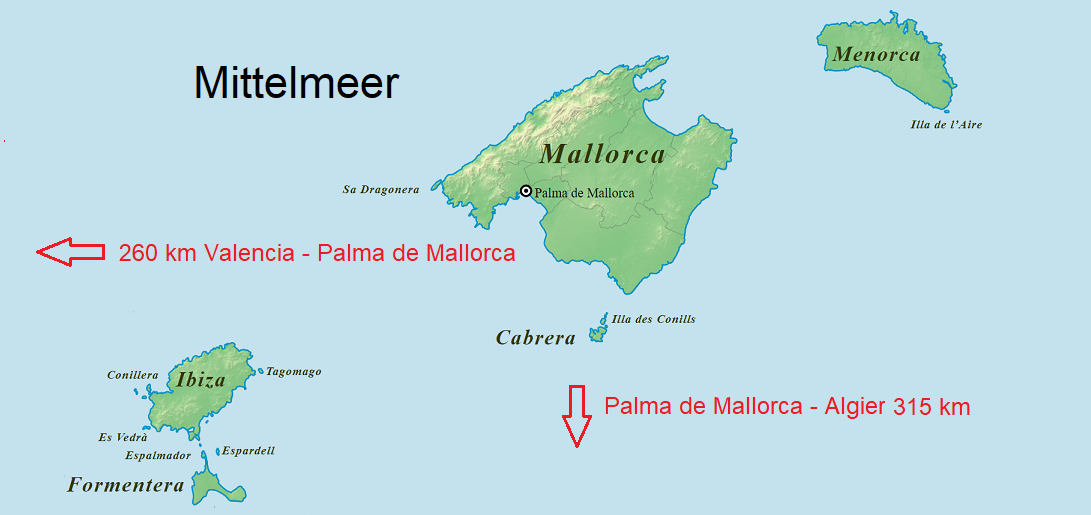The largest island (3,604 km²) of the Balearic archipelago belonging to Spain (the Catalan name means "the larger", as opposed to Menorca, "the smaller"). It lies in the western Mediterranean Sea about 170 kilometres from the Spanish mainland. The capital Palma is also located here. Mallorca is the seventh largest Mediterranean island. It stretches 98 km from east to west and 78 km from north to south. In addition to the main island of Majorca, the administrative area of Majorca also includes the Cabrera archipelago (18.4 km²) and the island of Sa Dragonera (2.9 km²).

Landscape areas
The "Serra de Tramuntana" mountain range, up to 15 km wide and over 90 km long, runs parallel to the northwest coast. The highest peak is the Puig Major at 1,445 m. On the side slopes of the mountains, tomatoes, beans and grapes are cultivated on terraced slopes. On the plain "Pla de Mallorca" in the central part, potatoes, rice, maize and vegetables as well as vines are cultivated and there are many almond tree plantations. In the northeast is the region of Llevant, which is crossed by the Serres de Llevant mountain range. There is a temperate subtropical climate with 8 hours of sunshine a day and sufficient rainfall. There are short, mild and humid winters and summers with little rain.
Viticulture
The Phoenicians probably brought viticulture to the Balearic Islands. Under Roman rule, wine was praised by Pliny the Elder (23-79). During the almost five centuries of Arab rule from the 8th to the 12th century, viticulture only lasted because dried grapes were an extremely popular foodstuff due to their long shelf life. In 1221, Jaime I (1213-1276) conquered the islands and later founded his own kingdom of Aragón. During this time, wine from Mallorca was even delivered to the Spanish royal court in Madrid. In the 19th century it was famous for its sweet Malvasia wines. A famous son of the island is the Franciscan monk Junipero Serra (1713-1784), born in Petra, who introduced the Spanish grape variety Listán Prieto (Misión) on a missionary trip to California and planted the first vineyard. He is therefore considered a winegrowing pioneer in the USA..
Wine-growing areas
Wine is grown almost everywhere on Mallorca. About 80% of the wines produced are red wines, which must contain at least 50% of the autochthonous main variety Manto Negro in the case of quality wines. There are two DO (quality wine) areas. This is the area 28 km from the capital Palma. Binissalem with the wine route "Ruta del Vino". The soils here consist of grey-brown and grey limestone and marl. The second DO area is Plà i Llevantwhich includes the plain (Plà) around the historic wine-growing towns of Manacor and Felanitx with the coastline (Llevant), from which the name derives. The climate there is more Mediterranean. The soils here are characterised by white or red limestone with clay layers.
There are also two IGP areas (country wines). These are the Mallorca area, which encompasses the island, and the Serra de Tramuntana-Costa Nord area in the mountain range. Well-known producers in Mallorca include the wineries José L. Ferrer - Franja Roja, Castell Miquel, Miquel Gelabert, Toni Gelabert, Miquel Oliver and Pere Seda.
Text source: WIKIPEDIA Mallorca
Map: by NordNordWest, Own work, using OpenStreetMap, CC BY-SA 2.0, Link
edited by Norbert F.J. Tischelmayer - June 2020
Voices of our members

I have great respect for the scope and quality of the wein.plus encyclopaedia. It is a unique place to go for crisp, sound information on terms from the world of wine.
Dr. Edgar Müller
Dozent, Önologe und Weinbauberater, Bad Kreuznach